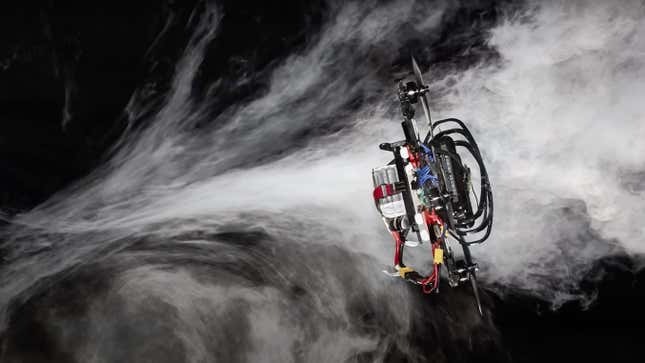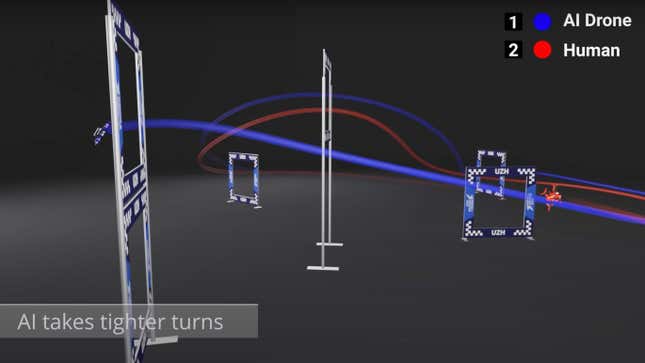
Well, chalk another victory up for the machines. After successfully beating humans in Chess, Go, and a variety of video games, AI has now beaten humanity’s best drone racers. Three world champion drone pilots were recently defeated in a competition by an autonomous, artificial-intelligence-powered drone called Swift. The AI-equipped drone, developed by researchers at the University of Zurich, came out on top in 15 out of 25 races and recorded the single fastest lap time, according to a paper published Wednesday in Nature.
“This work represents a milestone for mobile robotics and machine intelligence, which may inspire the deployment of hybrid learning-based solutions in other physical systems,” the researchers wrote.
Swift beat the humans in the niche but growing sport of first-person view drone racing. Human competitors navigate using a headset connected to a camera on their drones to pilot a quadcopter through complex obstacle courses at extreme speeds, with the goal of finishing the race with the fastest time and avoiding taking too much damage in the process. Drones in these races can top 50 miles per hour when they’re really buzzing. The video below shows Swift battling it out against the human-controlled drones.
Swift emerged victorious in 15 out of the 25 total head-to-head races against the human pilots and clocked the fastest overall lap time at 17.47 seconds. That brisk lap time was nearly half a second better than the best human. The three human competitors, Alex Vanover, Thomas Bitmatta, and Marvin Schaepper, have each won drone racing championships in the past.
In this case, the human competitors had a week to learn the new course and train for the race. During that same time, Swift was training as well but in a digitally simulated environment meant to resemble the course. Swift, according to the paper, used deep reinforcement learning while in the simulation along with additional data collected from the outside world. If deep reinforcement learning sounds familiar, it’s because that’s the same training method used by previous AI models to outperform humans in Chess, Go, and even StarCraft.
Drone racing stands out from those previous examples, however, because it involves a physical object moving through the real world, unconstrained by the set limitations of a board game or digital world. During the actual race, Swift would take in video collected by its camera and send that to a neural network capable of identifying the gates it had to fly through. A combination of onboard sensors are then used to aid the drone with positioning, speed, and orientation. All of this happened autonomously, at extreme speeds.
The researchers noticed some interesting differences in the ways Swift approached the course as opposed to its human competitors. The autonomous system, they noted, was more consistent across laps and appeared to take tighter turns. Those tight turns can add up and give a drone an edge in a race by repeatedly shaving off fractions of a second from lap times.

Swift’s performance appeared to shock the human champions.
“That was insane,” Bitmatta can be heard yelling out during one of his races against Swift. “The possibilities are endless, this is the start of something that could change the whole world,” Bitmatta added in the research paper.
Others, however, like Schaepper, seemed to be left with a sense of dejection.
“It feels different racing against a machine, because you know that the machine doesn’t get tired,” he said.